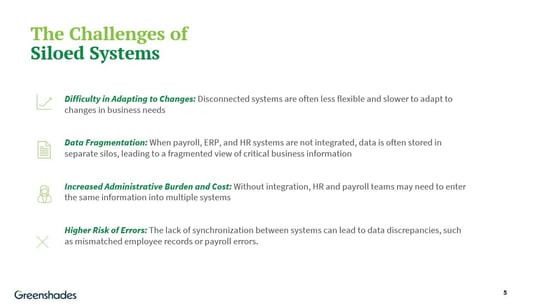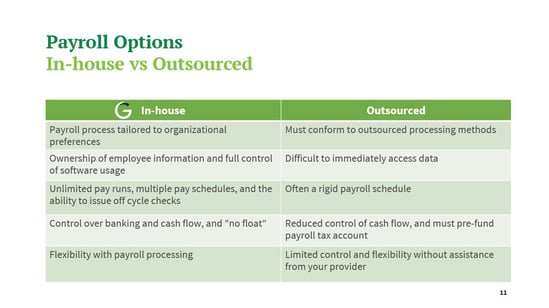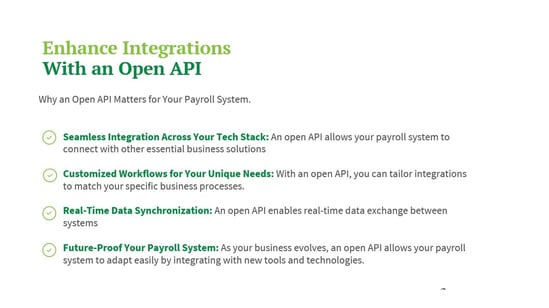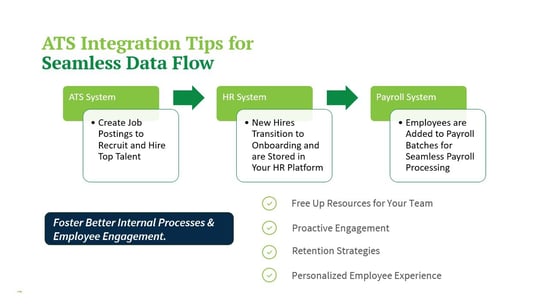In our recent webinar, Don't Leave Payroll in the Dust, attendees explored the critical role payroll plays in digital transformation. The session covered how integrating payroll with ERP, timekeeping, and ATS systems can elevate business operations and drive efficiency. Our experts shared insights on the benefits of payroll integration, strategies for seamless implementation, and practical tips for optimizing processes to support growth.
Watch the full webinar here:
Addressing Siloed Systems
The webinar began by highlighting the challenges of using disconnected payroll, ERP, and HR systems. Siloed systems increase the risk of compliance issues and hinder adaptability. Integrated systems, however, streamline data flow, reduce errors, and provide a unified view of essential business information.
Payroll’s Role in Business Growth 
By integrating payroll with ERP, timekeeping, and HR systems, businesses can automate manual tasks, reduce administrative overhead, and ensure accurate payroll processing. This supports growth through real-time insights into labor costs and profitability, helping leadership make informed decisions.
ERP and Payroll Integration
 Attendees learned how the integration between payroll and your ERP of choice enhances reporting capabilities, supports financial planning, and provides key insights for strategic growth. We discussed specific ERP systems like Dynamics 365, Sage Intacct, and Acumatica, showing how payroll integration can offer seamless, bi-directional data transfer, real-time accuracy, and financial transparency.
Attendees learned how the integration between payroll and your ERP of choice enhances reporting capabilities, supports financial planning, and provides key insights for strategic growth. We discussed specific ERP systems like Dynamics 365, Sage Intacct, and Acumatica, showing how payroll integration can offer seamless, bi-directional data transfer, real-time accuracy, and financial transparency.
In-house vs. Outsourced Payroll 
We compared in-house payroll processing, which offers flexibility and control, with outsourced payroll, which reduces resource demands. Attendees learned how to evaluate the right approach for their organization based on control, resource allocation, and operational needs.
Handling a Payroll Transition
Attendees were then guided through steps to ensure a smooth payroll transition, including conducting a thorough assessment of the current setup, planning for data accuracy and compliance, leveraging configurable payroll setups, and engaging in parallel testing. Integration with supporting systems was emphasized as key to minimizing errors during the transition.
Open API Benefits 
The session also covered how open APIs enhance integrations by enabling payroll systems to connect with other business solutions. Open APIs allow real-time data synchronization, customized workflows, and scalability, ensuring payroll systems can adapt to future needs.
Applicant Tracking System (ATS) Integration 
Attendees learned how ATS integration improves recruiting, onboarding, and overall employee experience. Automated recruiting tasks and smooth transitions to HR and payroll enhance engagement and retention, contributing to long-term employee satisfaction.
Timekeeping and Scheduling Integration
The discussion on integrating scheduling software with payroll demonstrated how this reduces administrative burdens, ensures compliance with labor laws, and improves shift management. Accurate PTO tracking and centralized data management also streamline workforce management. 
The webinar concluded with a focus on integrating timekeeping and PTO policies into payroll, highlighting the importance of accurate time tracking, centralized data management, automated accruals and deductions, and compliance reporting. Attendees were reminded of the advantages of ensuring that all timekeeping and PTO data are seamlessly integrated into payroll processes.
Strategies for Successful Integration

We concluded with practical strategies for overcoming integration challenges: evaluating system compatibility, leveraging marketplace partners, planning for scalability, and managing data migration. These steps help ensure a smooth transition and long-term success.
For more information or to see how Greenshades can optimize your payroll integration, reach out for a personalized demo.

























.jpg)


